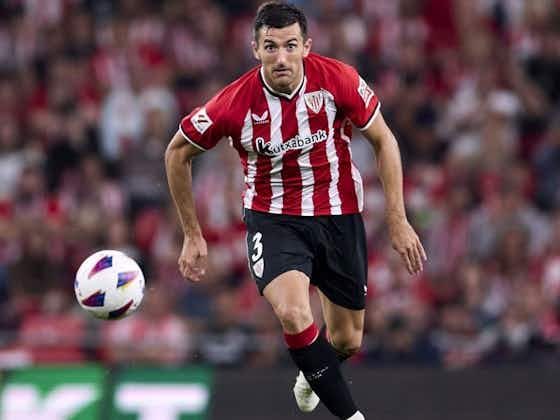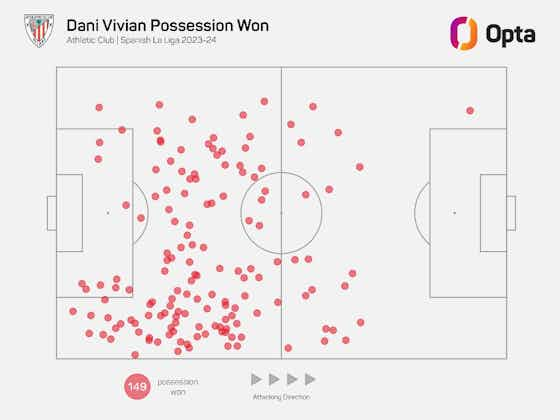Football Espana
·16 January 2024
COLUMN: Why Dani Vivian symbolises Valverde’s all-conquering Athletic Club

In partnership with
Yahoo sportsFootball Espana
·16 January 2024

Picture Ernesto Valverde’s Athletic in your mind, and the images will more than likely zero in on something occurring in the opposition half. The asphyxiating pressure from the front two and wingers, the searing speed in transition, and that forward inertia that never quite seems to fade. This Athletic side – in this form – play in the opposition half, whether they have the ball or not.
That sense-shattering inertia – which ran through another opponent at the weekend – is primarily and rightly attributed to the likes of Inaki and Nico Williams. While the former is playing the best football of his career and finally settled into a permanent role, his younger brother Nico is looking increasingly ahead of schedule in a career of infinite promise. What was once a novelty in that two siblings would share the pitch together is now a crucial part of the team’s framework, and one through which Valverde’s side have become capable of steamrolling much of what stands before them.
A team that plays with the collective force that Athletic do, however, can’t only be achieved by having a menacing front line. To explain why they’re playing in such vintage Athletic fashion, it’s just as fair to start from the back as it is to put the game-changers up top between the crosshairs. Los Leones go through teams from the front, but the force is often channelled from behind.
For most of this season, it’s felt as if you can’t talk about one without talking about the other. Such is the strength of their partnership, Dani Vivian and Aitor Paredes are difficult to split, and no doubt observers of the duo will all have their particular feelings behind who will go on to become the superior player. That they’re the centre back pair who have played the most minutes together in La Liga this season (1,503), as well as the one with the most clean sheets to their name (8), speaks to a pair defined by complimentary attributes above all.
With all due respect to Paredes, if we’re to pick the player who best represents what Athletic are at the present moment – specifically in terms of their playing style and its success – then it is surely Vivian we ought to (ruefully) individualise.
“On the pitch, you look to your right and see him there straight as a stick, really serious. It’s almost as if he’s ready to retire at 35 years old,” Paredes says of Vivian, in an interview with DEIA. “It’s not something he puts on for the public, it’s his personality; he’s serious, forthright, as if he’s the oldest player.”
That attitude is what drives Vivian’s play on the pitch. He is, as Carlo Ancelotti would say, a “pessimistic” defender; someone who behaves as if the worst is about to happen, rather than assuming he’s been afforded a moment of tranquillity. That base setting is what gets a defender their chance and the prospects to keep it, but the territory Vivian is now entering is starting to look like something much more emphatic than that.
Athletic are the team that has recovered the ball – on average – furthest from their own goal in La Liga this season (44 metres), yet they pair that with the second-best defensive record according to expected goals (just over one per game). Vivian figures as a player who can defend in both directions with increasing dominance. While the 24-year-old sets the example for Athletic’s ‘forward’ style of defending, where they try to squeeze the game from the halfway line and trap the opponent in their own half, his agility and speed of recovery is the failsafe that allows Valverde’s side to press forward with more conviction than they might otherwise have.
Vivian has recovered possession an average of 7.5 times per 90 in LaLiga this season, the most of any centre back. Wrapped up in that headline figure is the combination of seizing on possession in distinct scenarios; namely the split between winning the foot race when the opposition try to play over the top of Athletic and recouping the ball in higher areas once they’ve squeezed the imprecision from their opponent. Not limited to just the former, Vivian has recovered the ball more often in the middle third of the pitch than any other centre back in La Liga this term too (3.2 times per 90).

In the case of the 24-year-old, his speed in the open field lends confidence in his ability to contest duels far from his own goal, while his proficiency in doing so means that on good days for Athletic, he doesn’t have to make up much ground. The fact is Vivian’s mere presence, which gives pause to the opponent thinking about playing over the top of Athletic’s defence collides with the risks that are implied by trying to play around the home side at San Mames. On many occasions this season, it has felt like a case of pick your poison for those who roll through Bilbao.
As we’ve seen all season – and especially so in the Basque derby at the weekend – Vivian’s development has seen Athletic become more and more able to take teams into those moments of doubt. Along all three lines of the pitch, from the front to back, los Leones cut the figure of a team who are primed to bite. And most crucially, they bring the tools to protect themselves against teams who daren’t provoke those bites, instead opting to bypass those first two lines.
A defensive line can, of course, never be about just one player, especially not in one as well positioned as Athletic’s has been this season. However, there are cases like Vivian who transform the capacity of a rearguard, expanding the terrain on which the line can defend itself, and in certain cases, weaponising it to the benefit of their team on the attacking end.
Athletic Club may have had better centre backs than Dani Vivian, but in the arena of sustaining a team who dominate for their out-of-possession hostilities, not many can stack up with the native of Vitoria-Gasteiz. And as he edges ever closer to his 100th appearance for the club, at just 24 years of age, we might well have to revise the first part of this paragraph one day.






























































